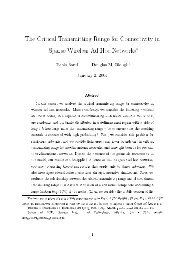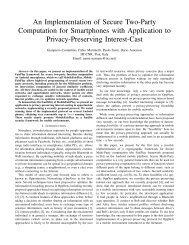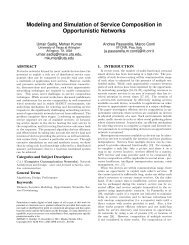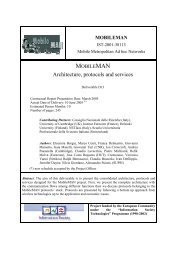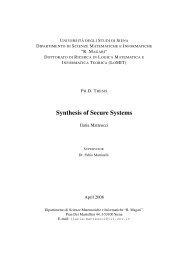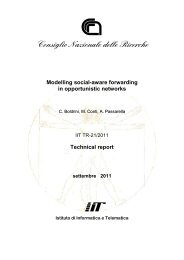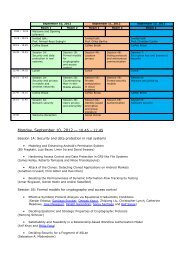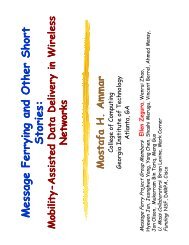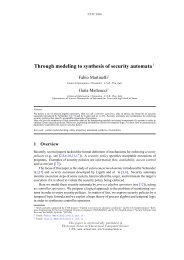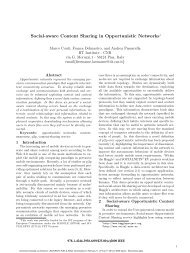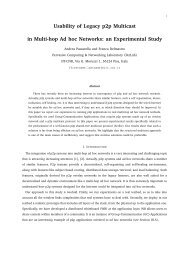Data Dissemination in Opportunistic Networks using ... - IEEE Xplore
Data Dissemination in Opportunistic Networks using ... - IEEE Xplore
Data Dissemination in Opportunistic Networks using ... - IEEE Xplore
Create successful ePaper yourself
Turn your PDF publications into a flip-book with our unique Google optimized e-Paper software.
Hit Rate10.80.60.40.20Ch. Thr. = 3Ch. Thr. = 5Ch. Thr. = 10Ch. Thr. = 151 10 100 1000 10000TimeFigure 6. Hit Ratio with an Item threshold = 10data dissem<strong>in</strong>ation efficiency. Specifically, analytical modelsare required to understand the impact and the <strong>in</strong>terplayof the parameters. For example, results presented <strong>in</strong> thepaper already highlight a non-trivial jo<strong>in</strong>t effect on thedata dissem<strong>in</strong>ation efficiency played by the thresholds usedby the different recognitions heuristics. Furthermore, understand<strong>in</strong>ghow data dissem<strong>in</strong>ation works when additionalcontext <strong>in</strong>formation (such as social relationships betweenusers) is exploited is another <strong>in</strong>terest<strong>in</strong>g topic. F<strong>in</strong>ally, it willalso be <strong>in</strong>terest<strong>in</strong>g to understand whether other heuristics(beyond recognition) can be effectively applied to the datadissem<strong>in</strong>ation or other related problems.Hit Rate10.80.60.40.2Mem = 2Mem = 50VIII. ACKNOWLEDGEMENTSThis work is funded by the EC under the FET-AWARENESS RECOGNITION Project, grant 257756.REFERENCES[1] Abdullah Balamash and Marwan Krunz. An overview of web cach<strong>in</strong>greplacement algorithms. <strong>IEEE</strong> Communications Surveys and Tutorials, 6(1-4):44–56, 2004.0Figure 7.1 10 100 1000 10000TimeHit Ratio with Variable Memory Sizesedge of the problem space and very limited resources. In thispaper we present an <strong>in</strong>itial attempt to exploit these models(already established and coded <strong>in</strong> the cognitive psychologyfield) to drive data dissem<strong>in</strong>ation processes <strong>in</strong> opportunisticnetwork<strong>in</strong>g environments. Specifically, we show how a fastand frugal cognitive heuristic, i.e. the recognition heuristic,can be used. The recognition heuristics discrim<strong>in</strong>ates objectswith respect to a given criterion, without requir<strong>in</strong>g to collectall the <strong>in</strong>formation needed to exactly compute the criterion.It assumes that recognized objects have higher value (withrespect to the criterion) than non recognized objects, anddiscrim<strong>in</strong>ates among them accord<strong>in</strong>gly. Several <strong>in</strong>stances ofrecognition can be cha<strong>in</strong>ed together, <strong>in</strong> order to model howthe human bra<strong>in</strong> discrim<strong>in</strong>ates <strong>in</strong> complex scenarios, solv<strong>in</strong>gefficiently complex decision mak<strong>in</strong>g problems. In this paperwe adapt these models to address the data dissem<strong>in</strong>ationproblem <strong>in</strong> content-centric mobile networks. We first def<strong>in</strong>ean algorithm by way of which the recognition heuristic canbe implemented by the nodes of an opportunistic network.Then, we show how nodes can efficiently comb<strong>in</strong>e multiple<strong>in</strong>stances of the recognition heuristic to assess the relevanceof available data objects, thus decid<strong>in</strong>g what to store andwhat to drop. Simulation results show the potential of suchan approach and highlight how a correct tun<strong>in</strong>g of theheuristic parameters leads to a fast and highly effectivedissem<strong>in</strong>ation of data items. In particular, the emergence ofthe less-is-more effect (well understood <strong>in</strong> the cognitive psychologyfield) highlights that an optimal configuration existsfor the recognition algorithm to obta<strong>in</strong> the best performance.Results presented <strong>in</strong> this paper are promis<strong>in</strong>g, and providestrong <strong>in</strong>dications that us<strong>in</strong>g cognitive heuristics to copewith scalability issues <strong>in</strong> Future Internet environments is asensible direction. Key topics for future research <strong>in</strong>clude acomplete understand<strong>in</strong>g of the heuristic parameters on the[2] Chiara Boldr<strong>in</strong>i, Marco Conti, and Andrea Passarella. Design and performanceevaluation of contentplace, a social-aware data dissem<strong>in</strong>ation system foropportunistic networks. Comput. Netw., 54:589–604, March 2010.[3] Chiara Boldr<strong>in</strong>i and Andrea Passarella. Hcmm: Modell<strong>in</strong>g spatial and temporalproperties of human mobility driven by users’ social relationships. Comput.Commun., 33:1056–1074, June 2010.[4] Paolo Costa, Cecilia Mascolo, Mirco Musolesi, and Gian Pietro Picco. Sociallyawarerout<strong>in</strong>g for publish-subscribe <strong>in</strong> delay-tolerant mobile ad hoc networks.<strong>IEEE</strong> Journal on Selected Areas <strong>in</strong> Communications, 26(5):748–760, 2008.[5] Gerd Gigerenzer and Daniel G. Goldste<strong>in</strong>. Models of ecological rationality:The recognition heuristic. Psychological Review, 109(1):75–90, 2002.[6] Daniel G. Goldste<strong>in</strong> and Gerd Gigerenzer. Reason<strong>in</strong>g the fast and frugal way:Models of bounded rationality. Psychological Review, 103(4):650–669, 1996.[7] Daniel G. Goldste<strong>in</strong> and Gerd Gigerenzer. Fast and frugal forecast<strong>in</strong>g. Int.Journal of Forecast<strong>in</strong>g, 25:760–772, 2009.[8] V<strong>in</strong>cent Lenders, Mart<strong>in</strong> May, Gunnar Karlsson, and Clemens Wacha. Wirelessad hoc podcast<strong>in</strong>g. SIGMOBILE Mob. Comput. Commun. Rev., 12:65–67,January 2008.[9] Julian N. Marewski, Wolfgang Gaissmaier, and Gerd Gigerenzer. Goodjudgments do not require complex cognition. Cogn. Process, 11:103–121, 2010.[10] Julian N. Marewski, Wolfgang Gaissmaier, Lael J. Schooler, Daniel G. Goldste<strong>in</strong>,and Gerd Gigerenzer. From recognition to decisions: Extend<strong>in</strong>g andtest<strong>in</strong>g recognition-based models for multialternative <strong>in</strong>ference. PsychonomicBullet<strong>in</strong> & Review, 17(3):287–309, 2010.[11] Marco Monti, Laura Martignon, Gerd Gigerenzer, and Nathan Berg. The impactof simplicity on f<strong>in</strong>ancial decision-mak<strong>in</strong>g. In Proc. of CogSci 2009, July 29 -August 1 2009, Amsterdam, the Netherlands, pages 1846–1851. The CognitiveScience Society, Inc., 2009.[12] L. Pelusi, A. Passarella, and M. Conti. <strong>Opportunistic</strong> network<strong>in</strong>g: data forward<strong>in</strong>g<strong>in</strong> disconnected mobile ad hoc networks. Communications Magaz<strong>in</strong>e,<strong>IEEE</strong>, 44(11):134 –141, 2006.[13] Sascha Serwe and Christian Fr<strong>in</strong>gs. Who will w<strong>in</strong> wimbledon? the recognitionheuristic <strong>in</strong> predict<strong>in</strong>g sports events. J. Behav. Dec. Mak<strong>in</strong>g, 19(4):321–332,2006.[14] Liangzhong Y<strong>in</strong> and Guohong Cao. Support<strong>in</strong>g cooperative cach<strong>in</strong>g <strong>in</strong> ad hocnetworks. <strong>IEEE</strong> Trans. Mob. Comput., 5(1):77–89, 2006.[15] Eiko Yoneki, Pan Hui, ShuYan Chan, and Jon Crowcroft. A socio-awareoverlay for publish/subscribe communication <strong>in</strong> delay tolerant networks. InACM MSWiM 2007, pages 225–234, 2007.



